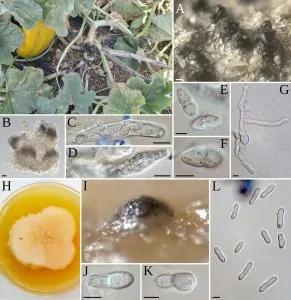Didymellaceae, Pleosporales, Dothideomycetes
Sphaeria cucurbitacearum
SYMPTOMS
The disease is known as black stem rot or gummy canker, due to the mass of pseudothecia (sexually reproducing fruiting bodies) and pycnidia (asexually reproducing fruiting bodies) that develop in the lesions and the gummy exudates that ooze from the active lesions on the stem and fruit. Symptoms appear on the leaves as irregular, watery, browning spots. Infection to the fruit usually starts from infected flowers, lesions often appear depressed or rotten underneath, infection may remain latent until after harvesting, which with increasing temperatures leads to rapid rotting. Infection and symptoms may occur throughout the plant with the exception of the roots. Disease levels may increase due to mechanical damage, high relative humidities and high nitrogen fertilisation.

Upper left part lesions on the stem and leaves, A Host pseudotheory group, B Pseudothecium under the microscope, C-D Asci with ascospores, E-F Ascosporas, G Ascospora germinated, H Cologne in MEA 2%., I Pycnidium on host, J-K Conidia emerging from the conidiogenous cell, L Group of conidia.
Scale: A 50 µm, B 20 µm, C-D 10 µm, E-G 5 µm, I 50 µm, J-L 5 µm
DESCRIPTION
Sexual form: Pseudothecium subepidermal, sparse to numerous, erumpent, superficial when host epidermis is detached, subglobose, 110-240 µm wide x 100-170 µm high (n=30), dark brown, ostiole 10-30 µm wide (n=30), papillate. Peridium 4-6 layers of brown cells, angular texture. Ascus bitunicate, cylindrical to clavate, (48-)50-)67(-70) x (9-)10-15(-17) µm (n=40). Ascospores hyaline, ellipsoid with rounded base and apex, 1 septum slightly constricted, (11-)12-14(-16) x (4-)5-6(-8) µm (n=40).
Asexual form: pycnidial conidiomycete, unilocular, solitary or confluent, ostiolate, slightly papillate, (70-)80-120(-150) µm (n=30). Peridium 2-3 layers of brown cells with angular texture. Conidiogenous cell fills inner layer of peridium, ellipsoid to subglobose, hyaline, 5-7×3-5 µm. Conidia cylindrical with rounded apices with a transverse septum, hyaline, 11-14 x 3-5 µm.
BIBLIOGRAPHY
https://www.indexfungorum.org
Keinath AP, Farnham MW, Zitter TA. Morphological, pathological and genetic differentiation of Didymella bryoniae and Phoma spp. isolated from cucurbits. Phytopathology. 1995;85:364-369.
Zitter T. Gummy Stem Blight. Vegetable Crops. Fact Sheet. 1992: 732. s





